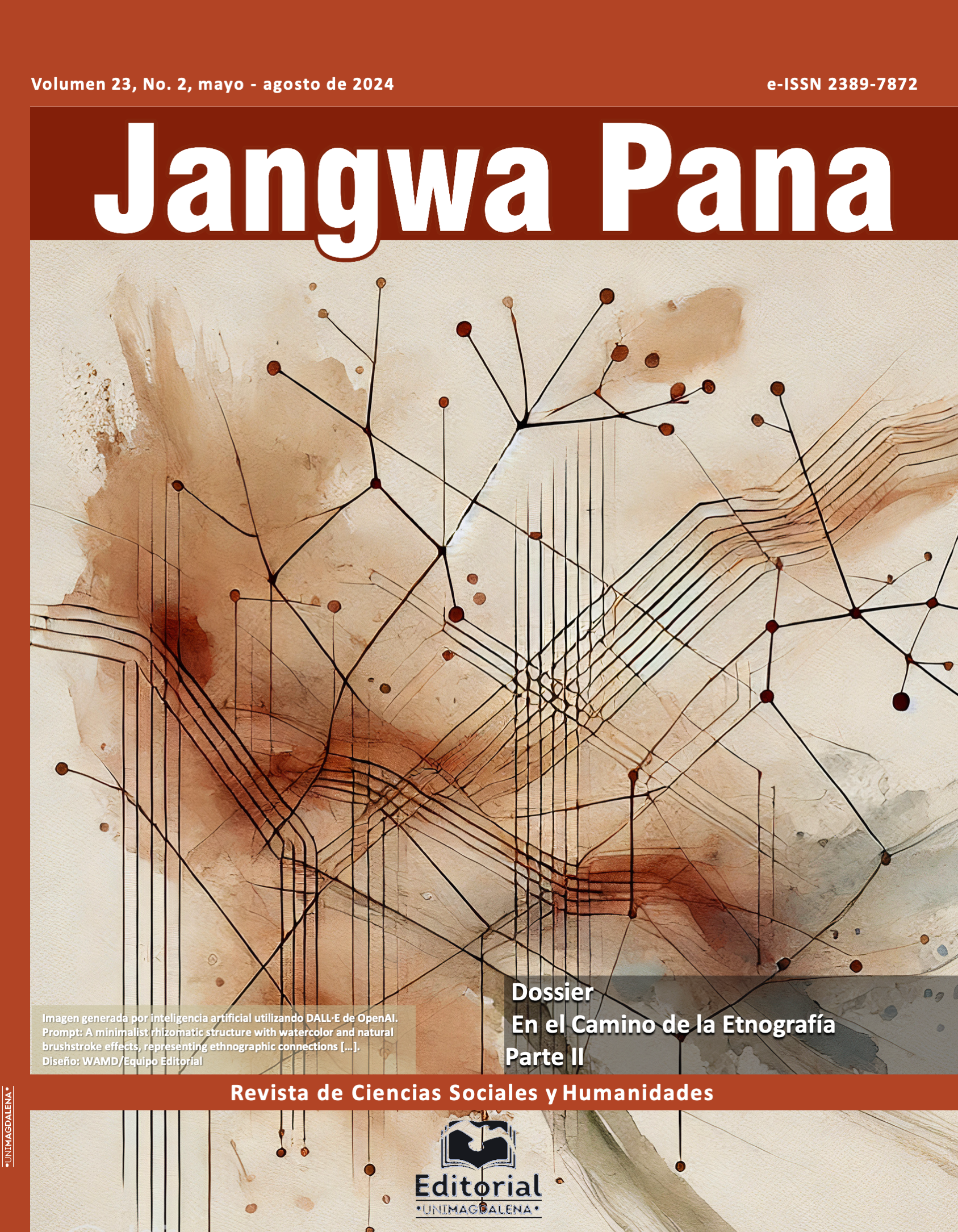Seris beings of the sea and the desert... from conversation to conservation in Hant comcaac, Sonora, Mexico
Main Article Content
Abstract
The Comcaac people located in Sonora, on the Gulf of California Coast, have coexisted with beings from the desert and the sea for centuries, until a few decades ago, they lived as nomads in their territory. These relationships have been modified through transformations in the life of the Comcaac nation, now more sedentary and integrated to the Mexican government, fishing, sport hunting networks and informal economies. They also change as diverse actors have begun to interact in the territory and with the Comcaac people. Today, scientists, mainly from the United States and Mexico (although sometimes you might find a lost Colombian), visit the Comcaac territory to research its people and ecosystems, and this interaction is transforming the ways in which humans and non-humans are entangling their actions and feelings. From conVerSation, the main form of interaction between the beings that inhabit the territory, we move on to conSerVation, a new form of relating to each other in nature. Neither of the two is exempt from power relations, but they are ontologies in conflict that reconfigure the ways of being in the world.
Downloads
Article Details
References
Blaser, M. (2009a). Political Cosmology. Cultural Studies, 23(5), 873-896. http://dx.doi.org/10.1080/09502380903208023
Blaser, M. (2009b). La ontología Política de un programa de caza sustentable. WAN E-journal, (4), 81-108. https://ram-wan.net/old/documents/05_e_Journal/journal-4/jwan4.pdf
Blaser, M. (2018). ¿Es otra cosmopolítica posible?. Anthropologica, 36(41), 117-144. http://www.scielo.org.pe/scielo.php?script=sci_arttext&pid=S0254-92122018000200008&lng=es&tlng=es.
Callon, M. (1986). Some Elements of a Sociology of Translation: Domestication of the Scallops and the Fishermen of St Brieuc Bay. En J. Law (Ed.), Power, Action and Belief: A New Sociology of Knowledge (pp. 196-233). Routledge & Kegan Paul.
Cano-Contreras, E. (2009). El papel de la cosmovisión en el conocimiento etnozoológico. En E. M. Costa Neto, D. Santos Fita, & M. Vargas Clavijo (coord.) Manual de Etnozoología. Una guía teórico-práctica para investigar la interconexión del ser humano con los animales (pp. 54-67). Tundra Ediciones.
Descola, P. (2012). Más allá de naturaleza y cultura. Amorrortu.
Duchesne, J. (2016, 9 de septiembre). La cosmopolítica, el animismo y el inmaterialismo de Graham Harman. 80 Grados. http://www.80grados.net/la-cosmopolitica-el-animismo-y-el-inmaterialismo-de-graham-harman/
Felger, R. S., y Moser, M. B. (1985). People of the Desert and Sea, Ethnobotany of the Seri Indians. The University of Arizona Press.
González, O., y Carro S. (2016). La apertura ontológica de la antropología contemporánea. Revista de Dialectología y Tradiciones Populares LXXI (1), 101-128. https://doi.org/10.3989/rdtp.2016.01.003
Guerrero, F., y Alvarez, R. (2019). Cosmovisión y conocimientos tradicionales sobre la fauna silvestre entre los tojol-ab'ales de Chiapas en En R. Perezgrovas, & E. Sedano (Eds.). Estudios sobre la fauna silvestre de México y las interacciones humano-animal (pp. 97-118). Red Mexicana sobre Conservación y Utilización de los Recursos Zoogenéticos. A.C.
Haber, A. (2011). Nometodología Payanesa: Notas de metodología indisciplinada (con comentarios de Henry Tantalean, Francisco Gil García y Dante Angelo). Revista Chilena de Antropología, (23), 9-49. https://revistadeantropologia.uchile.cl/index.php/RCA/article/view/15564
Latour, B. (2008). Reensamblar lo social: una introducción a la teoría del actor-red. Ediciones Manantial.
Luque, D., y Robles T. A. (2006). Naturaleza, saberes y territorios comcaác (seri). SEMARNAT, Instituto Nacional de Ecología.
Mitchel, T. 2013. ¿Puede hablar el mosquito?. En M. Cañedo (Ed.), Cosmopolíticas. Perspectivas antropológicas (pp. 299-340). Editorial Trotta.
Pálsson, G. (2001). Relaciones humanos-ambientales. Orientalismo, paternalismo y Comuninalismo. En P. Descola y G. Pálsson (Eds.), Naturaleza y sociedad. Perspectivas antropológicas (pp.80-100). Siglo XXI Editores.
Quintero, C. (2012). Birds of Empire, Birds of Nation. A History of science, economy and conservation in United-States-Colombia Relations. Universidad de los Andes.
Rentería, R. (2007). Seris. Pueblos indígenas del México contemporáneo. Comisión Nacional para el Desarrollo de los Pueblos Indígenas.
Torre, J., y Bourillon, L. (2011) Pescando Pelícanos y cantando a las tortugas en Relatos de fogata. Anécdotas y experiencias de biólogos y conservacionistas en el campo. March y Lazcano Editores. TNC. https://cobi.org.mx/wp-content/uploads/2020/05/Torre-Bourillon-2012-Seris-relatos.pdf
Ulloa, A. (2014). Escenarios de creación, extracción, apropiación y globalización de las naturalezas: emergencia de desigualdades socioambientales. En B. Göbel, M. Gongora-Mera y A. Ulloa (Eds.), Desigualdades socioambientales en América Latina (pp. 139-166). Universidad Nacional de Colombia-Ibero-Amerikanisches Institut. https://www.researchgate.net/publication/305637556_Escenarios_de_creacion_extraccion_apropiacion_y_globalizacion_de_las_naturalezas_emergencia_de_desigualdades_socioambientales
Ulloa, A. (2016). Feminismos territoriales en América Latina: defensas de la vida frente a los extractivismos. Nómadas, (45), 123-139. http://scielo.org.co/scielo.php?script=sci_arttext&pid=S0121-75502016000200009
Viveiros, E. (2003). Perspectivismo e multinaturalismo en América indígena. En A. Chaparro y C. Schumacher (Eds.), Racionalidad y discurso mítico (pp.225-233). Universidad del Rosario Instituto Colombiano de Antropología e Historia, ICANH.
Viveiros, E. (2010). Metafísicas caníbales. Líneas de antropología postestructural. Katz.
Zumbado-Arrieta, M. A. (7-8 de agosto de 2000). Parataxónomos y conservación de biodiversidad, la experiencia del INBio en Costa Rica. Foro de Café y Biodiversidad, Chinchiná. Chinchiná CENICAFÉ-COLCIENCIAS-Instituto Humboldt.
Referencias digitales
Siete Filos, 30 de marzo 2015. "Punta Chueca, April,1960. The capture of a Leatherback giant Pacific Sea Turtle (a very rare occasion) signalled the return of the Creator of the Seri world (the land was pushed up from the sea on "Her" back). URL: https://www.facebook.com/photo/?fbid=857428174324151&set=a.841096105957358
Ezequiel Molina, 2017. Fotografía compartida de Graig D. URL https://www.facebook.com/ezekiel.molinasesma
Grupo Tortuguero de las Californias. URL http://www.grupotortuguero.org/

